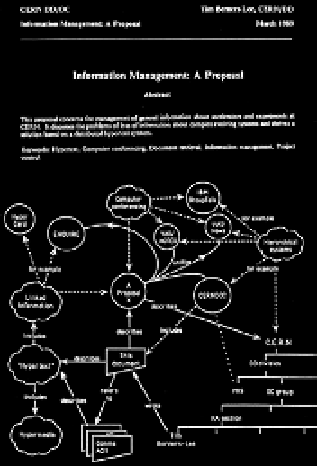Information Technology Reference
In-Depth Information
CERN was then in the process of updating the control systems for its par-
ticle accelerators, devices that propel subatomic particles to high speeds,
and Berners-Lee had been hired to help. For a temporary contract pro-
grammer, it was a major challenge to understand all the different com-
ponents of the control system and to know who was responsible for each
component. To help him keep track of all this information, Berners-Lee
wrote a software program called
Enquire
. The name was a shortened ver-
sion of the title of a how-to topic called
Enquire within upon Everything
, a
Victorian compendium of household advice that he remembered from
his childhood. In his Enquire system, Berners-Lee could input a page of
information about a person, a device, or a program, as he explained:
Fig. 11.5. An aerial view of the CERN laboratory
on the France-Switzerland border just outside
Geneva, Switzerland. The large circle shows
the location of the tunnel for the Large Hadron
Collider, the world's largest particle accelerator.
This machine made possible the discovery of the
Higgs boson by particle physicists in 2012.
Each page was a “node” in the program, a little like an index card. The only
way to create a new node was to make a link from an old node. The links
from and to a node would show up as a numbered list at the bottom of
each page, much like the list of references at the end of an academic paper.
The only way of finding information was browsing from the start page.
9
The program stored data in a much easier to use way than a traditional
rigid hierarchal organization by allowing links to different paths of informa-
tion. It had two types of links, an “internal” link within a file and an “exter-
nal” link that could jump between files. The external link went in only one
direction, which was important to avoid the problem of many people linking
to the destination page and the owner having to store many thousands of
return links. This initial program did not run on a network of computers but
on a stand-alone computer.
Berners-Lee left CERN after about six months but returned to their
Computing and Networks Division four years later. By this time, the researchers
working on large particle physics experiments routinely networked their com-
puters together, connecting the scientists working at CERN with one another
and with their home institutions. After a year or so mulling over the new
networked environment at CERN and his previous experiences with Enquire,
Berners-Lee decided that a new type of “document management system” was
needed that would essentially be a version of hypertext that operated over the
Internet. In order that users would not be required to obtain access permissions
from other users, the system would need to be completely decentralized with
no center of control and with no one keeping track of all the available links.
This decentralization was important because Berners-Lee was aware that this
was the only way that the system could scale to accommodate thousands and
even millions of users. Furthermore, he said, “the act of adding a new link had
to be trivial”
10
- because the easy addition of links was vital if his “web” of links
was to spread around the world. In late 1988, Berners-Lee talked to his boss,
Mike Sendall, who encouraged him to write up a proposal that would establish
his idea as a formal project (
Fig. 11.6
).
At that time, Vint Cerf and Bob Kahn's TCP/IP networking protocol for the
Internet was not well established in Europe. Nevertheless Berners-Lee chose to
adopt their protocol because the particle physics community used and loved
the Unix systems that all supported TCP/IP for network communications. In
March 1989, he gave a version of his proposal to Mike Sendall and Sendall's
Fig. 11.6. Tim Berners-Lee's original 1989
proposal for a novel hypertext-based
document management system at CERN.
The figure shows circles with arrows,
indicating documents, organizations, and
people all connected by electronic links
called hyperlinks.


Search WWH ::

Custom Search